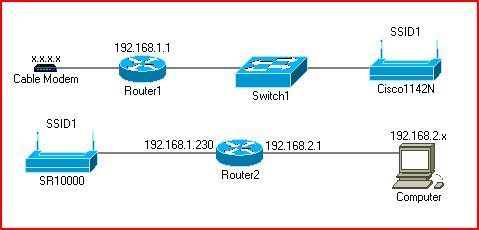I'm trying to figure out how to setup a static route to disable NAT, for a second router on the network which is providing DHCP to computers connected to it's LAN ports. I put the second router on a separate IP address, first router hooked up through the second routers WAN port. The first router is connected to the modem. The second router is configured with a static ip on the same ip range as the first router on the WAN port. Is it possible to configure a static route, and disable NAT?
Diagram of the setup I have right now.
Diagram of the setup I have right now.
Code:
::Windows Desktop / Windows Laptop / Linux Desktop / VoIP Phone::
192.168.2.x (DHCP Router2 assigned)
|
|
[ethernet]
|
|
192.168.2.1 LAN Port -- [ additional devices can receive DHCP from Router2 LAN ports ]
::Router2::
192.168.1.230 WAN Port
|
|
[ethernet]
|
|
LAN Port -- [ devices assigned static IP addresses connected to the LAN ports do work ]
::SR10000 / SR300 / RT-N12D1::
SSID1 Wireless
=
=
=
[wireless N 2.4Ghz] === [ many devices connected by SSID1 Wireless via DHCP Router1 assigned ]
=
=
=
SSID1 Wireless
::Cisco 1142N::
Ethernet Port
|
|
[ethernet]
|
|
::Switch1:: ---- [ many devices attached to this switch by ethernet via DHCP Router1 assigned ]
|
|
[ethernet]
|
|
192.168.1.1 LAN Port
::Router1::
x.x.x.x WAN Port (IP is dynamically assigned by ISP)
|
|
[ethernet]
|
|
Ethernet Port
::Cable Modem::
Cable connection
|
|
[cable wire]
|
|
...Internet...
Last edited:
![[H]ard|Forum](/styles/hardforum/xenforo/logo_dark.png)
